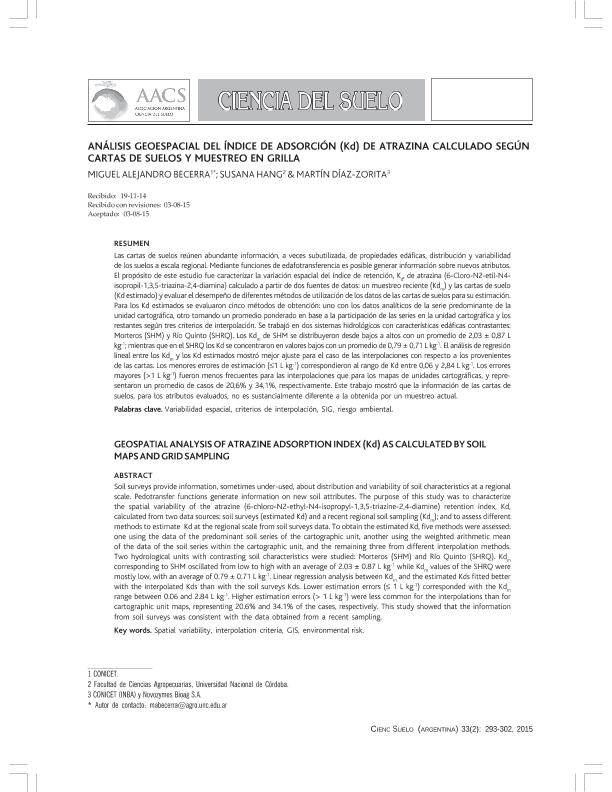Mostrar el registro sencillo del ítem
dc.contributor.author
Becerra, Miguel Alejandro

dc.contributor.author
Hang, Susana

dc.contributor.author
Diaz Zorita, Martin

dc.date.available
2023-09-01T16:41:49Z
dc.date.issued
2015-05
dc.identifier.citation
Becerra, Miguel Alejandro; Hang, Susana; Diaz Zorita, Martin; Análisis geoespacial del índice de adsorción (kd) de atrazina calculado según cartas de suelos y muestreo en grilla; Asociación Argentina de la Ciencia del Suelo; Ciencia del Suelo; 33; 2; 5-2015; 293-302
dc.identifier.issn
0326-3169
dc.identifier.uri
http://hdl.handle.net/11336/210195
dc.description.abstract
Se estudió el comportamiento de 14C-glifosato en la zona de transición rastrojo-suelo, en cuatro sitios y dos secuencias de cultivo: monocultivo de soja (Glycine max (L.) Merr.), y rotación soja-maíz (Zea mays L.). La adsorción-desorción se estudió mediante isotermas y se prepararon las mezclas suelo+rastrojo con 1,5% (p/p) de rastrojo (mezclasoja, mezclamaíz). La distribución entre las formas mineralizada (Min), extractable en agua (RE1) en hidróxido de amonio (RE2) y no extractable (RNE), se estudió mediante incubaciones en mezclasoja equivalió a 4,8 tn ha-1 y 8,8 tn ha-1 para mezclamaíz. Los índices Kfads, Kd, y Kco promedio de mezclamaíz (39,1 L kg-1; 39,9 L kg-1; 1822 L kg-1, respectivamente) superaron a los obtenidos en mezclasoja (35,1 L kg-1; 34,3 L kg-1; 1630 L kg-1). El Kco correlacionó significativamente con el C orgánico de las fracciones granulométricas del suelo, Cf <50µm (0,74, p<0.001), C orgánico de la fracción 2000-200 µm (-0,66, p<0.001) y 200-50µm (-0,59, p<0,001). La histéresis se incrementó con la adsorción. El porcentaje de 14C-CO2 liberado varió entre 59% a 76% del 14C inicial aplicado, en promedio 69% (mezclasoja) y 68% (mezclamaíz). Se detectó variabilidad entre mezclas del mismo rastrojo, en las mezclasoja (CV=10%) y en las mezclamaíz (CV=6%). Los RE1 representaron el 1,5 % (mezclasoja) y 1,1% (mezclamaíz), mientras que en mezclasoja el CV=65% y en mezclamaíz el CV= 34%. Los valores promedio y CV de los RE2 fueron respectivamente 22% y 31% (mezclasoja) y 24% y 21% (mezclamaíz). Los RNE representaron una pequeña fracción del total de la radioactividad, en promedio el 4,7% para ambas mezclas, con un CVsoja= 14% y CVmaíz= 17%. Nuestros resultados indican que la zona de transición rastrojo+suelo es una pequeña fracción, pero muy importante comportamiento de glifosato, y no debieran hacerse generalizaciones en base al tipo de rastrojo.
dc.description.abstract
Soil surveys provide information, sometimes under-used, about distribution and variability of soil characteristics at a regional scale. Pedotransfer functions generate information on new soil attributes. The purpose of this study was to characterize the spatial variability of the atrazine (6-chloro-N2-ethyl-N4-isopropyl-1,3,5-triazine-2,4-diamine) retention index, Kd, calculated from two data sources: soil surveys (estimated Kd) and a recent regional soil sampling (Kdm); and to assess different methods to estimate Kd at the regional scale from soil surveys data. To obtain the estimated Kd, five methods were assessed: one using the data of the predominant soil series of the cartographic unit, another using the weighted arithmetic mean of the data of the soil series within the cartographic unit, and the remaining three from different interpolation methods. Two hydrological units with contrasting soil characteristics were studied: Morteros (SHM) and Río Quinto (SHRQ). Kdm corresponding to SHM oscillated from low to high with an average of 2.03 ± 0.87 L kg-1 while Kdm values of the SHRQ were mostly low, with an average of 0.79 ± 0.71 L kg-1. Linear regression analysis between Kdm and the estimated Kds fitted better with the interpolated Kds than with the soil surveys Kds. Lower estimation errors (< 1 L kg-1) corresponded with the Kdm range between 0.06 and 2.84 L kg-1. Higher estimation errors (> 1 L kg-1) were less common for the interpolations than for cartographic unit maps, representing 20.6% and 34.1% of the cases, respectively. This study showed that the information from soil surveys was consistent with the data obtained from a recent sampling. Key words. Spatial variability, interpolation criteria, GIS, environmental risk.
dc.format
application/pdf
dc.language.iso
spa
dc.publisher
Asociación Argentina de la Ciencia del Suelo

dc.rights
info:eu-repo/semantics/openAccess
dc.rights.uri
https://creativecommons.org/licenses/by-nc-sa/2.5/ar/
dc.subject
Glifosato
dc.subject
Adsorción-desorción
dc.subject
Degradación
dc.subject
Mezcla suelo+rastrojo
dc.subject.classification
Otras Ciencias de la Tierra y relacionadas con el Medio Ambiente

dc.subject.classification
Ciencias de la Tierra y relacionadas con el Medio Ambiente

dc.subject.classification
CIENCIAS NATURALES Y EXACTAS

dc.title
Análisis geoespacial del índice de adsorción (kd) de atrazina calculado según cartas de suelos y muestreo en grilla
dc.title
Geospatial analysis of atrazine adsorption index (kd) as calculated by soil maps and grid sampling
dc.type
info:eu-repo/semantics/article
dc.type
info:ar-repo/semantics/artículo
dc.type
info:eu-repo/semantics/publishedVersion
dc.date.updated
2023-08-31T12:07:42Z
dc.identifier.eissn
1850-2067
dc.journal.volume
33
dc.journal.number
2
dc.journal.pagination
293-302
dc.journal.pais
Argentina

dc.journal.ciudad
Ciudad Autónoma de Buenos Aires
dc.description.fil
Fil: Becerra, Miguel Alejandro. Universidad Nacional de Córdoba. Facultad de Ciencias Agropecuarias; Argentina. Consejo Nacional de Investigaciones Científicas y Técnicas. Centro Científico Tecnológico Conicet - Córdoba; Argentina
dc.description.fil
Fil: Hang, Susana. Universidad Nacional de Córdoba. Facultad de Ciencias Agropecuarias; Argentina
dc.description.fil
Fil: Diaz Zorita, Martin. Consejo Nacional de Investigaciones Científicas y Técnicas. Oficina de Coordinación Administrativa Parque Centenario. Instituto de Investigaciones en Biociencias Agrícolas y Ambientales. Universidad de Buenos Aires. Facultad de Agronomía. Instituto de Investigaciones en Biociencias Agrícolas y Ambientales; Argentina
dc.journal.title
Ciencia del Suelo

dc.relation.alternativeid
info:eu-repo/semantics/altIdentifier/url/https://www.ojs.suelos.org.ar/index.php/cds/article/view/149
dc.relation.alternativeid
info:eu-repo/semantics/altIdentifier/url/http://www.scielo.org.ar/scielo.php?script=sci_arttext&pid=S1850-20672015000200013
Archivos asociados
